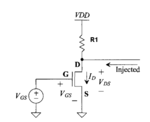Derun93
Member level 3

Hi everyone,
In the figure, according to the Mr.Baker's book, if we inject the current to drain, Id increases (I agree with that) so Vds increases since we keep Vgs constant. I agree with that too if we just look at the formula of Id= Idsat+Idsat*lambda*(Vds-Vdsat). However, if ı consider this situation in that way, Vd=Vdd-Id*R1, Vd must be going to decrease. According to the same book, Ro=1/(lambda*Idsat) so it does not change too. Please can somebody explain me this situation?
Thank you.

Note: It is a long-channel MOSFET.
In the figure, according to the Mr.Baker's book, if we inject the current to drain, Id increases (I agree with that) so Vds increases since we keep Vgs constant. I agree with that too if we just look at the formula of Id= Idsat+Idsat*lambda*(Vds-Vdsat). However, if ı consider this situation in that way, Vd=Vdd-Id*R1, Vd must be going to decrease. According to the same book, Ro=1/(lambda*Idsat) so it does not change too. Please can somebody explain me this situation?
Thank you.

Note: It is a long-channel MOSFET.
Last edited:
